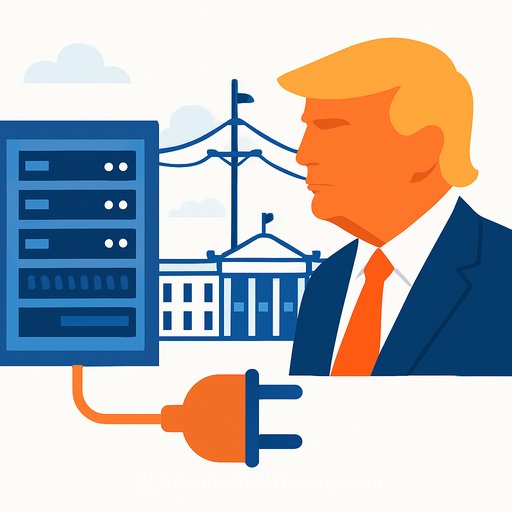Trump Administration Seeks 60-Day Fast Track for Data-Center Grid Connections
The Trump administration is asking federal regulators to speed up how quickly new data centers can connect to the grid. A draft proposal sent to the Federal Energy Regulatory Commission (FERC) calls for expedited interconnection reviews capped at 60 days - a sharp shift from the multi-year queues many projects face today.
If adopted, this could compress delivery timelines for AI capacity, shift site selection priorities, and change how leaders plan capital, power procurement, and risk. It's still a proposal, not a final rule, but the direction is clear: faster hookups for compute-heavy facilities.
What's on the table
The proposal urges FERC to create a fast-lane review for data-center grid connections, with a 60-day limit. That would force tighter coordination between developers, utilities, and grid operators. It won't eliminate upgrades or local permits, but it would redefine the pacing of approvals.
Expect pushback around grid reliability and cost allocation. Also expect a formal comment period and a FERC vote before anything takes effect.
Why this matters for management
Interconnection delays have been one of the biggest drags on AI buildouts. A 60-day cap would pull forward go-live dates, move revenue left on the timeline, and reduce carrying costs. It will also reward teams that are technically complete, procurement-ready, and able to respond fast to utility questions.
The flip side: faster reviews won't fix transformer lead times, substation constraints, or local siting issues. You'll need parallel paths to secure equipment, rights-of-way, and backup options.
Immediate actions to consider
- Audit your pipeline. Map every site's queue position, studied capacity, required upgrades, and critical path. Model an accelerated scenario and quantify the cash impact.
- Tighten interconnection packages. Lock load profiles, single-line diagrams, fault studies, and protection settings. In a 60-day window, incomplete files become instant delays.
- Pull forward procurement. Reserve transformers, switchgear, and relays. Negotiate cancellable or transferable slots to reduce stranded cost risk.
- Plan staged energization. Phase loads (IT first, then cooling expansions) to fit available capacity and de-risk upgrade timing.
- Rework commercial terms. Update PPAs or tariffs for demand charges, curtailment, and outage SLAs tied to a faster interconnect date.
- Secure onsite resilience. Validate genset capacity, fuel contracts, and storage to ride through constraints or curtailments.
- Prepare comms and community engagement. Local acceptance can still slow you down even if the grid review moves faster.
Risks and constraints to price in
- Queue reshuffling. A fast track may reorder priorities and trigger disputes. Build in schedule buffers.
- Upgrade dependencies. Even with a quicker review, big transmission or substation work can still take years.
- Reliability scrutiny. Expect tougher questions on stability, protection, and load-management plans for high-density sites.
- Regulatory timing. The proposal needs a formal FERC process. Don't bank the 60-day clock until a final rule is published.
What to watch next
Track the FERC docket, notice-and-comment steps, and any carve-outs that define which projects qualify for the 60-day window. Follow how utilities interpret "complete" applications and whether they add new technical prerequisites.
For background on FERC's role and process, see the commission's site here. For broader energy system context, the U.S. Energy Information Administration maintains data and analysis here.
Manager's checklist
- Have a red-team review your interconnection packages for completeness and grid-impact clarity.
- Stand up a weekly war room with utility contacts, EPC partners, and key vendors.
- Update project finance models with earlier energization scenarios and sensitivity cases.
- Align IT deployment plans to staged capacity (rack density, liquid cooling, and redundancy).
- Document contingency paths: alternate sites, temporary feeders, or mobile substation options.
If your organization is scaling AI programs alongside new capacity, align team skills with your build plans. A curated set of role-based learning paths can help leaders and operators move in sync: Courses by Job.
Your membership also unlocks:






